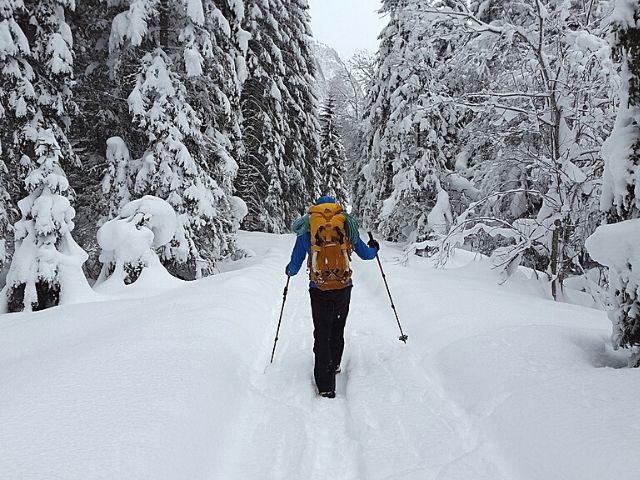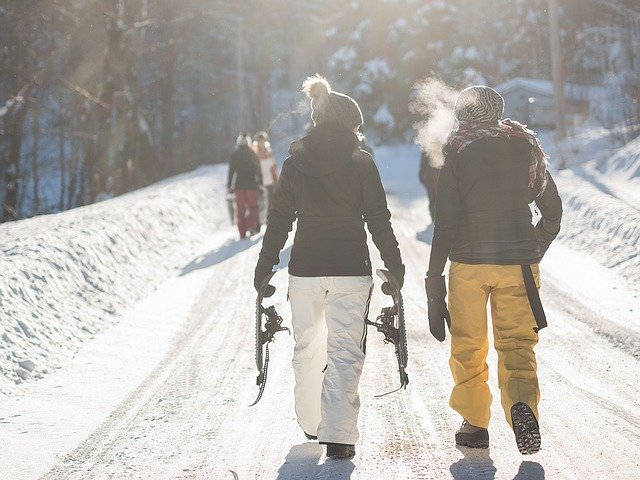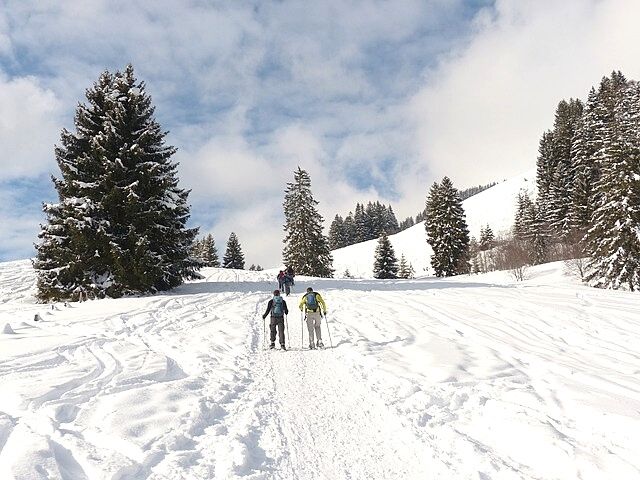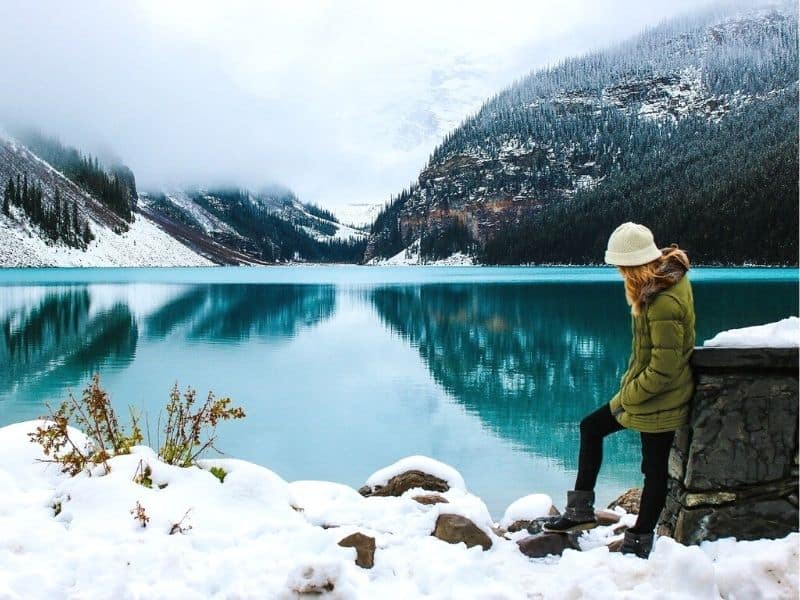When temperatures start to drop outside and the first snowfall blankets the ground, hikers often take this as their cue to put away their hiking boots for the year.
However, in doing so they are missing out on some amazing hiking opportunities, as winter and snow hiking can add a whole new dynamic to the hiking experience.
By turning hiking trails into winter wonderlands full of unique challenges and experiences.
However, if you plan to hike in the snow, there are some things you will need to take with you, to be fully prepared and to enjoy the hike.
So we created the below checklist of all the essential hiking gear you will need for your hike in the snow.
1. Layered Clothing
One of the most important items you will need while hiking in the snow and during winter is several layers of clothing.
Which will allow you to remove and add layers of clothing to regulate your temperature while hiking.
Because while the thermometer outside might be reading in the 40s, you will be amazed at how quickly you start to warm up once you start hiking.
So when it comes to layering, you want to start the hike with the most layers of clothing on and then slowly shed those layers as you start to warm up.
And then as you start to get cold, you want to reverse the process, by adding layers of clothing back on.
However, if you’re new to snow hiking and hiking in the winter, you might be wondering what layers of clothing you need while hiking in the snow?
Must-Have Layers of Clothing While Hiking in the Snow and During Winter
- Base Layer
- Wool T-shirt
- Long Underwear
- Long Sleeve Jersey
- Heavy Wool Socks
- Mid Layer
- Soft Shell Pants
- Fleece Jacket or Pullover
- Soft Shell Jacket
- Outer Layer
- Waterproof and Windproof Jacket with Attached Hood
- Puffy Insulated Jacket with Attached Hood
- Hard Shell Pants that are Windproof and Waterproof with Full-Length Zippers Down the Side
- Additional Clothing Items
- Thin Fleece or Wool Toboggan
- Heavy Fleece or Wool Toboggan
- Thin Fleece or Wool Gloves
- Waterproof Gloves Perfably with Insulated Liners
You might have noticed that there were no items of clothing made from cotton on this list.
And that’s for good reason, as you ideally want to avoid any clothing made from cotton while hiking in the snow, as they can take an especially long to dry if they get wet.
2. Waterproof Hiking Boots
Another item necessary for hiking in the snow is a good solid pair of waterproof hiking boots.
And while waterproof hiking boots can take many forms, below are some of the features they should have if you plan to hike with them in the snow.
Must-Have Hiking Boot Features for Hiking in the Snow
- Full Waterproof Capability – Look for hiking boots that offer full waterproofing capability. By choosing hiking boots that provide multiple layers of defense against water and moisture, by utilizing waterproof coatings, inner waterproof membranes like Gore-Tex, naturally water-resistant materials, and higher boot cuts.
- Aggressive Tread – Look for hiking boots that have a very aggressive and rugged soul that will offer plenty of traction and grip when traversing over slippery and wet surfaces such as snow, mud, wet rocks, outcroppings, and ice.
- Insulation – If you plan to hike with boots in the winter and in the snow, then you want a pair of hiking boots that will not only keep your feet dry but also warm by choosing a pair of insulated boots.
- Compatible with Winter Traction Aids – Ideally any hiking boot you choose for winter hiking should be compatible with winter traction aids such as crampons, microspikes, and snowshoe bindings.
When choosing winter hiking boots it’s also really important to choose a pair that fits your feet properly and that leaves enough room for you to wiggle your toes.
As this will help promote blood flow and circulation in your feet while hiking in the snow.
And if you’re looking for some suggestions on hiking boots great for hiking in the snow, below we’ve listed a few of our favorites.
- Salomon Men’s Chalten Ts CSWP Snow Hiking Boots
- KEEN Women’s Revel 4 Mid Height Polar Snow Boot
- KEEN Men’s Revel 4 EXP Mid Height Polar Snow Boot
- Merrell Women’s Aurora 6 Ice Plus Waterproof Snow Boot
3. Trekking Poles with Snow Baskets (Optional)

Even if you’re someone that doesn’t typically use trekking poles while hiking, you might want to consider bringing a pair with you, if you’re going to be hiking in the snow.
As trekking poles with snow baskets can really help you keep your balance and stay on your feet while hiking over slippery and uneven snow-covered terrain.
As they provide additional connection points with the ground, allowing for much better traction and control while hiking in the snow.
4. Winter Traction Aids (Optional)
While not always necessary while hiking in the snow, winter traction aids can be a real-life saver, if you know you’re going to be hiking a trail with a mixture of snow as well as ice.
As winter traction aids such as microspikes or crampons, which slip on over the bottom of your hiking boots have little metal teeth or spikes that will bite into the ice to provide additional traction and grip while hiking over ice or extremely slippery terrain.
5. Snowshoes (Optional)

Another piece of hiking gear that’s great to have while hiking in snow is snowshoes.
Because if you’re hiking in snow that’s deeper than 10 inches, snowshoes are a must-have, as they will allow you to walk on top of the snow instead of sinking into with every step.
Which will make it much easier and help to save a lot of energy while hiking in deep snow.
Keep in mind though that there is definitely a time to use snowshoes and a time not to use them.
Because while snowshoes make hiking in deep snow much easier, they can also be much more cumbersome and awkward to walk in.
So you only want to break out the snowshoes, when you’re hiking in snow deeper than 10 inches.
6. Other Gear You Should Bring While Hiking in Snow
What else you will need beyond the above-listed hiking gear depends largely on the type of snow hike you’re going on.
As obviously a hiker or backpacker going on a multi-day winter hike through the backcountry will need far more gear and equipment than a hiker going on a casual one or two-mile hike at their local state park.
But regardless of which type of winter hike you’re going on you might want to consider bringing the below hiking gear and outdoor gear with you to make your winter snow hike more comfortable as well as more enjoyable.
Additional Snow Hiking Gear
- Backpack – If you’re going on a multi-day hike a backpack is a must but even if you’re just going on a few-hour hike, a small backpack can be super handy to hold extra clothing, water bottles, trail mix, snowshoes, and microspikes, etc…
- Water – Don’t let the lower temperatures in winter lull you into a false sense of security around water, because while you might not need as much water while hiking in colder weather, you still need to consume plenty of water while hiking.
- High Energy Calorie Dense-Snacks – While hiking and burning calories, it’s important to keep your energy up by bringing high energy and calorie-dense snacks with you.
- Extra Pair of Wool Socks – While waterproof boots should keep your feet warm and dry if you have to do a water crossing while hiking, it’s still possible your socks could get wet, which is why it’s a good idea to bring an extra pair of wool socks.
- Sunglasses – While winter days are often cloudy if the sun does pop out while hiking in the snow, the snow can be blinding, which is why you should always bring a pair of sunglasses with you while hiking in the snow.
- First Aid Kit – Whether hiking in summer or hiking in the winter it’s always a good idea to bring a small first aid kit with you while hiking just in case.
- Survival Gear – Survival gear can take many forms but when hiking in the winter and the snow, it’s a good idea to have at least some survival gear with you, such as a compass, map of the area, headlamp or flashlight, fire starter kit, whistle, sunscreen, and toilet paper.
Is it Safe to Go Hiking in the Snow?
Hiking in the snow is a great way to enjoy the quiet solitude nature offers in the winter, however, it can also be hazardous as well as dangerous, if the proper precautions are not taken to protect yourself from cold and freezing temperatures as well as slip and fall injuries.
So below are our top eight tips to make sure your winter snow hike is not only fun but also safe.
8 Ways to Stay Safe While Hiking in the Snow
- Hike While the Suns Up – The daytime will always be the warmest time of the day during winter, so make sure you start your hike early, to ensure you finish long before the sun starts to drop.
- Stay Safe in Numbers – While it’s always a good idea to hike with a partner, it becomes especially important, while hiking in the snow due to increased risks.
- Layer Up – When hiking in the winter and the snow, you always want to wear several layers of clothing, so you can shed layers when you get warm and add layers when you get cold.
- Protect Your Feet – Your feet can be one of the most vulnerable parts of your body when hiking in the snow, so make sure you’re hiking in a quality pair of insulated waterproof hiking boots and have a heavy pair of wool socks on underneath.
- Check the Trail Status – Hiking trails can often be closed during the winter due to dangerous hiking conditions, so you should always check to see if the hiking trailer is open before heading out.
- Watch for Snow Hazards – Hiking in the snow adds several snow-specific hazards that you need to watch out for including frozen rivers, snow-covered cliffs, and avalanches.
- Know the Weather – It’s also a good idea to check the weather before you go because you don’t want to get suck in a snowstorm while hiking.
- Bring Survival Essentials – For longer hikes in the snow, it’s a good idea to bring some survival gear with you such as food and water for a few days, a first aid kit, a flashlight, a fire starter, a small emergency shelter, a multi-tool, and several ways to call for help such as a cell phone, emergency beacon, whistle, or flair.
How Cold is too Cold to Hike?
While there are a lot of opinions out there about how cold is too cold for hiking, in general, anything above 40 degrees Fahrenheit is usually considered acceptable hiking temperatures, as long as you’re prepared and dressed for cold weather hiking.
However, how cold is too cold for hiking in a lot of ways comes down to personal preference and level of preparedness for cold weather and freezing temperatures, as there are many mountaineers and experienced cold weather backpackers and hikers that hike in temperatures well below freezing.
But the sweet sport for the average hiker just wanting to enjoy an easy-to-moderate winter hike with minimal provisions and preparations is between 40 and 50 degrees Fahrenheit.
As the closer, you get to freezing temperatures while hiking the more specialized knowledge you need to have about how to stay warm and how to avoid cold-weather dangers such as frostbite and hypothermia.
What Shoes to Wear for Hiking in the Snow?
One of the best ways to make your hike in the snow more enjoyable as well as safer is to choose the appropriate shoes or footwear.
Because the wrong shoes while hiking in the snow can quickly lead to cold and wet feet that can not only make your hike miserable but also be extremely dangerous due to the threat of frostbite and hypothermia.
So when choosing shoes for hiking in the snow, you want to choose footwear that helps to keep your feet warm and dry, by choosing a good quality pair of insulated waterproof hiking boots like a pair of Salomon Men’s Chalten Ts CSWP Snow Hiking Boots or a pair of KEEN Women’s Revel 4 Mid Height Polar Snow Boots.
What Pants Should I Wear for Winter Hiking?
While you might be tempted to just throw on an old pair of blue jeans, while winter hiking, it’s best to avoid pants made of denim or cotton while hiking in the winter.
As denim and cotton materials are very absorbent materials that take a very long time to dry, if they become saturated, neither of which is a good thing while hiking in the winter.
So when winter hiking, it’s best to go with a pair of either soft shell pants or hard shell pants or a combination of the two, as they are made from synthetic materials, which do not absorb water and offer a layer of waterproofing.
And in the case of hard shell pants, they also provide a nice windbreak from cold winter winds, which always make it feel colder outside than what the temperature actually reflects.

How Much Harder is it to Hike in Snow?
While snow provides an amazing backdrop for hiking, as it turns the most ordinary of trails into winter wonderlands it also creates a much more challenging hike as well.
As it is much harder to hike in the snow.
But just how much harder depends on several factors such as the type of snow you’re hiking in, how deep the snow is, and what type of hiking gear you have.
But, in general, you should expect it to be about 50% harder to hike in the snow, due to the extra resistance of the snow and increased level of difficulty in maintaining balance and transaction.
As there have been several studies done that show that hiking in the snow can burn up to 50% more calories.
How Fast Can You Walk in Snow?
Most people will typically walk at a pace between 1 to 2 miles per hour while walking in the snow.
However, this doesn’t mean a whole lot until you compare this speed against other common outdoor activities.
So to give you an idea of how fast 1 to 2 miles per hour is, we’ve listed the average miles per hour for other outdoor activities.
| Walking in Snow | 1 to 2 MPH |
| Hiking | 2 MPH |
| Walking | 3 to 4 MPH |
| Snowshoeing | 3 MPH |
| Running | 6 MPH |
| Cross Country Skiing | 5 to 8 MPH |
| Cycling | 14 to 16 MPH |
To see other fun things you can do in the winter, check out our article “18 Fun Things to Do While Winter Camping“.

